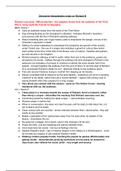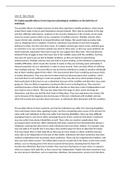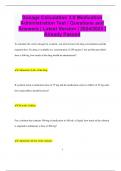Week 1..................................................................................................................................................... 3
Article 1: The resource-based view within the conversation of strategic management (Mahoney
& Pandian, 1992) ................................................................................................................................ 3
Article 2: Navigating a path to smart growth (Raisch & Von Krogh, 2007) ...................................... 4
Article 3: The limits to profitable growth rate (Snoeren, 2018)........................................................ 5
Article 4: Risk Reduction as a Managerial Motive for Conglomerate Mergers (Amihud & Lev,
1981).................................................................................................................................................... 6
Article 5: Resource-Based Theory and Corporate Diversification (Wan et al., 2011) ...................... 6
Article 6: Corporate diversification (Montgomery, 1994) ................................................................. 8
Week 2..................................................................................................................................................... 9
Article 7: The end of history for corporate law (Hansmann & Kraakman, 2001) ........................... 10
Article 8: Strategy research: governance and competence perspectives (Williamson, 1999) ....... 11
Article 9: Ownership of the firm (Hansmann, 1988) – PART 1 ........................................................ 12
Article 10 & 12 combined: Separation of ownership and control (Fama & Jensen, 1983) & Agency
problems and residual claims (Fama & Jensen, 1983) .................................................................... 13
Week 3................................................................................................................................................... 15
Article 9: Ownership of the firm (Hansmann, 1988) – PART 2 ........................................................ 15
Article 12: Value maximization, Stakeholder theory and the Corporate objective function
(Jensen, 2002) ................................................................................................................................... 16
Article 13: The corporate objective revisited (Sundaram & Inkpen, 2004) .................................... 17
Article 14: Instrumental stakeholder theory: a synthesis of ethics and economics (Jones, 1995) 18
Article 15: Strategic CSR: a concept building meta-analysis (Vishwanathan et al., 2019) ............. 19
Week 4................................................................................................................................................... 20
Article 16: The choice of organizational governance form and performance: predictions from
transaction cost, resource-based and real options theories (Leiblein, 2003) ................................ 20
Article 17: Making more by doing less: an analysis of outsourcing and its effect on firm
performance (Gilley & Rasheed, 2000) ............................................................................................ 21
Article 18: Governance and competence: how can they be combined? (Nooteboom, 2004) ....... 22
Article 19: Fairness and transaction costs: the contribution of organizational justice theory to an
integrative model of economic organization (Husted & Folger, 2004)........................................... 23
Article 20: The process of vertical dis-integration: an evolutionary perspective on outsourcing
(Mahnke, 2001) ................................................................................................................................. 25
Article 21: Management control systems and trust in outsourcing relationships (Langfield-Smith
& Smith, 2003) .................................................................................................................................. 28
Week 5................................................................................................................................................... 29
Article 22: Performance of serial acquirers: toward an acquisition program perspective
(Laamanen & Keil, 2008)................................................................................................................... 29
1
, Article 23: Toward unlocking the full potential of acquisitions: the role of organizational
restructuring (Barkema & Schijven, 2008) ....................................................................................... 30
Article 24: Cooperative strategy and source of interorganizational competitive advantage (Dyer
& Singh, 1998) ................................................................................................................................... 32
Article 25: How to make strategic alliances work (Dyer et al., 2001) ............................................. 34
Article 26: Finding the right path (Capron & Mitchell, 2010) .......................................................... 35
Week 6................................................................................................................................................... 36
Article 27: The structuring of organizations (Mintzberg, 1979) ...................................................... 36
Article 28: Matrix organization designs – how to combine functional and project forms
(Galbraith, 1971) ............................................................................................................................... 39
Article 29: The functions of the HQ unit in the multibusiness firm (Chandler, 1991) .................... 40
Article 30: Beyond the M-form: towards a managerial theory of the firm (Bartlett & Ghoshal,
1993).................................................................................................................................................. 42
Article 31: A network perspective on organizational architecture: performance effects of the
interplay of formal and informal organization (Soda & Zaheer, 2012) .......................................... 43
Study questions & learning objectives .................................................................................................. 45
Week 1 .............................................................................................................................................. 45
Week 2 .............................................................................................................................................. 46
Week 3 .............................................................................................................................................. 47
Week 4 .............................................................................................................................................. 48
Week 5 .............................................................................................................................................. 50
Week 6 .............................................................................................................................................. 52
2
,Week 1
Corporate strategy is the pattern of decisions in a company that determines and reveals its objectives,
purposes, or goals, and defines the range of businesses the company is to pursue, the kind of economic and
human organization it is or intends to be, and the nature of the economic and noneconomic contribution it
intends to make to its shareholders, employees, customers, and communities.
Article 1: The resource-based view within the conversation of strategic management
(Mahoney & Pandian, 1992)
The resource-based approach presents explanations for diversification strategies and performance.
RBV in a nutshell:
• Types of rent: rent is excess return over resources’ opportunity costs and can be achieved in a
form of ricardian rent (owning scarce resources), monopoly rent (high barriers to competition,
collusions), entrepreneurial/ Schumpeterian rent (uncertainty/temporary) or quasi-rent (owning
firm-specific resources).
• Sources of rent: rents exist when resources are valuable, rare, inimitable, non-substitutable and
nontradeable, which depends on lack of competition in acquiring or developing complementary
assets. Rents also depend on the resource positions of the firm in terms “strengths” and
“weaknesses” (SWOT) and differences between firms’ information, luck and capabilities.
• Distinctive competences: a firm may achieve rents not because it has better resources, but rather
the firm’s distinctive competence involve making better use of its resources (capability) which
depends on know-how and managerial ability. Managerial abilities depend on managers’
perceptions (dominant logic) which is shaped by the firm’s current resources and influences the
direction of growth of firms. Thus, the resource profile influences the direction of diversification.
Hence, the RBV contributes to research on diversification strategies in multiple ways:
• Limits to growth: the resources of the firm limit the choice of markets it may enter, and the levels
of profits it may expect by shortage of labor or physical inputs, shortage of finance, lack of suitable
opportunities or lack of sufficient managerial capacity. Hence, long-term growth of the firm is
limited by internal management.
o Penrose effect: management is both the accelerator and the break for a firm’s growth
process. Managerial activities to carry out new ventures to expand are partially
constrained by the time they need to run current activities as well. Thus, when a firm is
growing, it needs more managers to avoid a lack of managerial input. Yet, recruiting new
managers costs a lot of time and effort of existing managers to educate them. Therefore,
after a period of rapid growth, a firm’s growth rate will stagnate because managerial inputs
fall short and are eventually even more constrained by recruiting new managers that need
time to be fully integrated. As fast-growing firm will encounter managerial problems and
thus slow down its growth in the next period.
→ A higher interdependence between resources will lower a firm’s growth rate.
• Motivation for growth: excess capacity due to unused expertise, indivisibilities (ondeelbaarheid)
and cyclical demand drives the diversification process. At all times there exist within every firm
pools of unused productive services, and these, together with the changing knowledge of
management, create unique productive opportunities for each firm. Specialization is also needed to
grow and diversify unused pools. An optimal growth rate of the firm involves balancing exploitation
of current resources and development of new resources.
• Direction of growth: the direction of a firm’s diversification process depends on the nature of
available resources and market opportunities. Firms attempt to transfer intangible (firm-specific)
assets to relatable activities and to industries that are related to primary activities. Thus, companies
grow in the directions set by their capabilities and these capabilities slowly expand and change.
3
, • Diversification & performance: there still is a debate ongoing about whether firms’ performance
is determined by firm-specific resources or by merger & acquisitions (attractiveness of industry).
o Firm-effect: in terms of focus-effect. Firms that are widely diversified have less firm-
specific resources, so they lose focus and are unable to transfer their competencies to new
markets. A given resource will lose value when transferred to markets that are less similar.
Narrowly diversified firms receive more rents because they have more firm-specific
resources that are enhanced (in value) by the related activities (more focus).
o Acquisitions: related acquisitions get higher rent than unrelated acquisitions, because of
greater synergies in terms of complementarities or increased market power.
Contestable synergies are present in unrelated diversification and involve resources that
are competitively available. This often leads to the appropriation of all value to the target
firm. (→Think of value capture theory in which P=OC because of monopolistic competition,
so supplier cannot capture max. value of WTP.)
Idiosyncratic bilateral synergies are often the case in related diversification and emerge
from resources that only create value when combined. The relation between both parties
is bilateral which leads to more equal appropriation of the value created.
Thus, related acquisitions get higher rent because they can create idiosyncratic bilateral
synergies that enables capturing a bigger part of the value created.
Article 2: Navigating a path to smart growth (Raisch & Von Krogh, 2007)
How fast should a company grow? Companies need to grow to remain vital and competitive, but it also
creates managerial challenges and can lead to crises or even bankruptcy. Managers should balance the need
to grow with the ability to manage the growth.
Growth corridor: model that poses a minimum and maximum growth for companies in which they should
stay.
• Minimum growth: benefits from growth can lead to market power and economies of scale/scope. It
can prevent organizational inertia and help in business renewal. There are three main reasons
(benefits) to grow:
o Competition: grow to keep up with competitors and become more efficient.
o Shareholders’ expectations: firms get a reward for meeting long-term growth
expectations of shareholders and penalties for failing to do so (stock prices).
o Productivity: grow to increase learning and use resources in a more productive way to
avoid excess capacity, since reinvesting is less costly than divesting.
• Maximum growth: too much growth can create problems such as loss of control or lower financing
capabilities. Three main reasons to limit growth (pitfalls of growing too fast):
o Financial: when sales growth increases beyond a sustainable growth rate (SGR), debts are
relatively higher than annual sales a firm can achieve and firms will operate above their
capacity.
o Managerial: there is a limited ability to find, train and integrate new management of
sufficient quality at a fast enough rate without undermining operational efficiency or
further growth. Here, sustainable growth rate related to the ability of managers to conduct
both tasks efficiently.
o Market: growing competition can eventually lead to lower profitability as a result of price
wars to capture market share from rivals. To avoid this, companies can diversify to other
markets.
Companies are more successful (higher shareholder returns) when growth exceeds the minimum growth
threshold – in which competitive growth is the most important – and when growth is below the maximum
growth threshold (sustainable growth rate)– in which managerial capabilities are the most important.
Smart growth: optimum growth path is between competitive growth and sustainable growth rate. Smart
growers are more successful and share the following characteristics:
4





